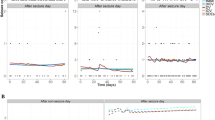Abstract
The number of counts (events) per unit of time is a discrete response variable that is generally analyzed with the Poisson distribution (PS) model. The PS model makes two assumptions: the mean number of counts (λ) is assumed equal to the variance, and counts occurring in non-overlapping intervals are assumed independent. However, many counting outcomes show greater variability than predicted by the PS model, a phenomenon called overdispersion. The purpose of this study was to implement and explore, in the population context, different distribution models accounting for overdispersion and Markov patterns in the analysis of count data. Daily seizures count data obtained from 551 subjects during the 12-week screening phase of a double-blind, placebo-controlled, parallel-group multicenter study performed in epileptic patients with medically refractory partial seizures, were used in the current investigation. The following distribution models were fitted to the data: PS, Zero-Inflated PS (ZIP), Negative Binomial (NB), and Zero-Inflated Negative Binomial (ZINB) models. Markovian features were introduced estimating different λs and overdispersion parameters depending on whether the previous day was a seizure or a non-seizure day. All analyses were performed with NONMEM VI. All models were successfully implemented and all overdispersed models improved the fit with respect to the PS model. The NB model resulted in the best description of the data. The inclusion of Markovian features in λ and in the overdispersion parameter improved the fit significantly (P < 0.001). The plot of the variance versus mean daily seizure count profiles, and the number of transitions, are suggested as model performance tools reflecting the capability to handle overdispersion and Markovian features, respectively.




Similar content being viewed by others
References
Miller R, Frame B, Corrigan B, Burger P, Bockbrader H, Garofalo E, Lalonde R (2003) Exposure–response analysis of pregabalin add-on treatment of patients with refractory partial seizures. Clin Pharmacol Ther 73:491–505
Jonker DM, Voskuyl RA, Danhof M (2004) Pharmacodynamic analysis of the anticonvulsant effects of tiagabine and lamotrigine in combination in the rat. Epilepsia 45:424–435
Cox DR (1983) Some remarks on overdispersion. Biometrika 70:269–274
Gupta SK, Sathyan G, Lindemulder EA, Ho PL, Sheiner LB, Aarons L (1999) Quantitative characterization of therapeutic index: application of mixed-effects modeling to evaluate oxybutynin dose-efficacy and dose-side effect relationships. Clin Pharmacol Ther 65:672–684
Godfrey CJ (2007) Mixed effects modelling analysis of count data. In: Ette EI, Willliams PJ (eds) Pharmacometrics: the science of quantitative pharmacology. Wiley-Interscience, New York
Cameron AC, Trivedi PK (1998) Regression analysis of count data. Cambridge University Press, Cambridge, UK
Slymen DJ, Ayala GX, Arredondo EM, Elder JP (2006) A demonstration of modeling count data with an application to physical activity. Epidemiol Perspect Innov 3:1–9
Del Castillo J, Pérez-Casany M (2005) Overdispersed and underdispersed Poisson generalizations. J Stat Plan Inference 134:486–500
Karlsson MO, Schoemaker RC, Kemp B, Cohen AF, van Gerven JMA, Tuk B, Peck CC, Danhof M (2000) A pharmacodynamic Markov mixed-effects model for the effect of temazepan on sleep. Clin Pharmacol Ther 68:175–188
Zingmark PH, Kågedal M, Karlsson MO (2005) Modelling a spontaneously reported side effect by use of a Markov mixed-effects model. J Pharmacokinet Pharmacodyn 32:261–281
Ito K, Hutmacher M, Liu J, Qiu R, Frame B, Miller R (2008) Exposure–response analysis for spontaneously reported dizziness in pregabalin-treated patient with generalized anxiety disorder. Clin Pharmacol Ther 84:127–135
Beal SL, Sheiner LB, Boeckmann AJ (eds) (1989–2006) NONMEM users guides. ICON Development Solutions, Ellicott City, MD
Heilbron DC (1994) Zero-altered and other regression models for count data with added zeros. Biometrical J 36:531–547
Shroeder DV (2000) Stirling’s approximation. Appendix B.3. In: An introduction to thermal physics. Addison-Wesley, MA
Karlsson MO, Holford N (2008) A tutorial on visual predictive checks, p 17. Abstr 1434 [www.page-meeting.org/?abstract=1434]
Cox EH, Veyrat-Follet C, Beal SL, Fuseau E, Kenkare S, Sheiner LB (1999) A population pharmacokinetic-pharmacodynamic analysis of repeated measures time-to-event pharmacodynamic responses: the antiemetic effect of ondansetron. J Pharmacokinet Biopharm 27:625–644
Author information
Authors and Affiliations
Corresponding author
Appendices
Appendix 1: Basic dataset structure used during the analyses of count data
See Table 5.
Appendix 2: NONMEM model file corresponding to the Negative Binomial model used for parameter estimation

Appendix 3: NONMEM model file corresponding to the Negative Binomial model used for model simulation


Rights and permissions
About this article
Cite this article
Trocóniz, I.F., Plan, E.L., Miller, R. et al. Modelling overdispersion and Markovian features in count data. J Pharmacokinet Pharmacodyn 36, 461–477 (2009). https://doi.org/10.1007/s10928-009-9131-y
Received:
Accepted:
Published:
Issue Date:
DOI: https://doi.org/10.1007/s10928-009-9131-y




